Research on Frost Heaving Characteristics of Hydraulic Tunnels’ Wall Rock in Cold Regions Based on Phase Transition and Water-Heat-Stress Coupling
Abstract
:1. Introduction
2. Water-Heat-Stress Coupled Control Equations Considering Water-Ice Phase Transition
2.1. Basic Assumptions
- (1)
- The rock mass is an isotropic continuous medium;
- (2)
- The rock mass can be considered as an ideal elastic material;
- (3)
- The porosity of the rock mass is constant and always in a saturated state;
- (4)
- The heat conduction of the rock mass satisfies the Fourier Law, and the seepage flow satisfies the Darcy Law;
- (5)
- The deformation of the rock mass is small, which conforms to the conditions of using the Terzaghi Effective Stress Principle.
2.2. Control Equation of Temperature Field Considering Phase Transition
2.3. Control Equation of Seepage Field Considering Phase Transition
2.4. Control Equation of Stress Field Considering Phase Transition
2.5. Initial Conditions and Boundary Conditions
3. Analysis of On-Site Monitoring Results of Frozen Area and Frost Heaving Force of Tunnels in Cold Regions
3.1. Project Overview
3.2. Analysis of On-Site Monitoring Results of Frozen Area and Frost Heaving Force
3.2.1. On-Site Monitoring Scheme
3.2.2. Analysis of the Variation Law of Frozen Area and Frost Heaving Force
- (1)
- In the same section, the temperature changes at different depths from the axis of the cave were different. The closer to the axis of the cave, the more severely the temperature changed, and the earlier the amplitude appeared.
- (2)
- The amplitude of the temperature change at the same position on different sections was different. As the tunnel depth increased, the temperature amplitude gradually decreased, indicating that the temperature field distribution of wall rock at the tunnel entrance section was different along the depth.
- (3)
- Taking 0 °C as the freezing temperature, as the tunnel depth increased, the frozen depth of the rock mass gradually decreased, and the radius of the frozen area gradually decreased. Connecting the freezing circles of different sections into a curved surface, the frozen area of tunnel wall rock along the tunnel depth can be obtained. According to the variation law of the frozen area of the monitoring section, it can be inferred that the frozen area of wall rock showed a funnel-shaped distribution, and the inner radius of the funnel decreased with the increase of the tunnel depth.
4. Numerical Simulation of Frost Heaving Characteristics of Hydraulic Tunnels’ Wall Rock in Cold Regions
4.1. Model Establishment
4.2. Determination of Parameters
4.3. Subsection
4.3.1. Verification of Calculation Results
4.3.2. Analysis of the Spatial Distribution and Variation Law of the Frozen Area
4.3.3. Analysis of the Spatial Distribution and Variation Law of the Frost Heaving Force
- (1)
- In different time periods, the maximum absolute values of wall rock frost heaving force were on cross sections. With the increase of depth, the absolute values of wall rock frost heaving force were decreasing. The frost heaving force of the wall rock was divided into a steep decline zone and a slow decline zone at the distance of 20 m away from the tunnel entrance. In the first 20 m range of the entrance, the absolute value of frost heaving force changed rapidly with the increase of depth. In the 20 m~100 m range of the entrance, the absolute values of frost heaving force slowly decreased with the increase of depth.
- (2)
- The absolute value of frost heaving force at the arch top, arch waist and arch bottom had an increasing trend from day 30 to 150 and had a decreasing trend from day 150 to 210. During day 30 to 150, the absolute value of maximum frost heaving force at arch top increased from 0.137 MPa to 0.705 MPa, with a growth rate of 414.6% and the absolute value of maximum frost heaving force at arch waist increased from 0.124 MPa to 0.471 MPa, with a growth rate of 279.8%. During day 150 to 210, the absolute value of maximum frost heaving force at arch top decreased from 0.705 MPa to 0.325 MPa, with a decreasing rate of 53.9% and the absolute value of maximum frost heaving force at arch waist decreased from 0.471 MPa to 0.215 MPa, with a growth rate of 54.4%. In the whole process, the value and variation trend of frost heaving force at arch top and arch bottom was basically the same. The growth rate of the maximum frost heaving force at the arch top and arch bottom was about 1.5 times that of the arch waist. Therefore, the arch top and arch bottom are affected more significantly by the frost heaving force.
- (3)
- The frost heaving forces at the arch waist were basically the same on day 170 and 150, which were significantly greater than that on day 130 in the same place. However, the frost heaving forces of day 170 at all locations were closer to the frost heaving forces on day 130 at the same places, and significantly greater than the frost heaving forces on day 170 at the same places. This means the value of the frost heaving force at the arch top entered the decline period earlier than that at the arch waist.
5. Conclusions
- (1)
- The model verification showed that the maximum error of freezing depth between the monitoring values and the simulation results was 0.26 m, and the error of the frost heaving force between the monitored and simulated results at the arch top, arch waist and arch bottom was within 8%. Therefore, it can be concluded that the numerical calculation results of three-dimensional finite element based on the derived coupling governing equation are in good agreement with the measured values, and the model has better reliability.
- (2)
- During the freezing period of the hydraulic tunnel in cold regions, the frozen area of the hydraulic tunnel was spatially distributed in a long-necked funnel shape. Due to the effect of ground temperature as well as convection and heat conduction of the free face and tunnel cavity, the frozen area in wall rock increased first and then decreased during the entire freezing period. Due to the hysteresis of heat conduction, the peak of the maximum freezing depth appeared after the minimum value of the ambient temperature.
- (3)
- The circumferential distribution law of frost heaving force in wall rock remained consistent. Comparing the variation of circumferential stress distribution of three cross sections, ZKY1, ZKY2 and ZKY3, on five freezing time points, we can find that the wall rock frost heaving forces are symmetrical vertically and horizontally, the maximum frost heaving force is at the arch top and arch bottom and the maximum frost heaving pressure is at arch top.
- (4)
- Taking 20 m away from the tunnel entrance as the boundary, the frost heaving force at the arch top and arch waist of wall rock can be divided into a steep decline zone and a slow decline zone. The maximum frost heaving force of the wall rock was at the entrance section. The absolute value of frost heaving force of the arch top, arch waist and arch bottom at the entrance section had an increasing trend from day 30 to 150, and a decreasing trend from day 150 to 210. However, the growth rate of maximum frost heaving force at the arch and bottom is about 1.5 times that at the arch waist, indicating that the influence of frost heaving on the arch top and arch bottom was greater than that on the arch waist. Thus, the arch top and arch bottom are affected more significantly by the frost heaving force.
Author Contributions
Funding
Institutional Review Board Statement
Informed Consent Statement
Data Availability Statement
Conflicts of Interest
References
- Ma, W.; Wang, D.Y. Studies on frozen soil mechanics in China in past 50 years and their prospect. Chin. J. Geotech. Eng. 2012, 34, 625–640. [Google Scholar]
- Zhang, M.Y.; Pei, W.S.; Li, S.Y.; Lu, J.G.; Jin, L. Experimental and numerical analyses of the thermal-mechanical stability of an embankment with shady and sunny slopes in permafrost regions. Appl. Therm. Eng. 2017, 127, 1478–1487. [Google Scholar]
- Liu, S.H. Lessons of hydraulic tunnel accident. Water Resour. Hydropower Eng. 2000, 31, 38–40. [Google Scholar]
- Zhang, Y.X. Study on Frost Resistance, Anti-Freezing and Drainage Technology of the Galongla Tunnel. Master’s Thesis, Chongqing Jiaotong University, Chongqing, China, 2009. [Google Scholar]
- Brovka, G.P.; Ivanov, S.N. Calculation of temperature fields in the ground with water-ice phase transitions in the temperature spectrum. J. Eng. Phys. Thermophys. 2004, 77, 1192–1200. [Google Scholar]
- Tan, X.J.; Chen, W.Z.; Jia, S.P.; Lv, S.P. A coupled hydro-thermal model for low temperature rock including phase change. Chin. J. Rock Mech. Eng. 2008, 27, 1455–1461. [Google Scholar]
- Tan, X.J.; Chen, W.Z.; Tian, H.M.; Cao, J.J. Water flow and heat transport including ice-water phase change in porous media:Numerical simulation and application. Cold Reg. Sci. Technol. 2011, 68, 74–84. [Google Scholar]
- Zhang, X.D.; Wu, Y.J.; Zhai, E.C.; Ye, P. Coupling analysis of the heat-water dynamics and frozen depth in a seasonally frozen zone. J. Hydrol. 2020, 593, 125603. [Google Scholar]
- Bekele, Y.W.; Kyokawa, H.; Kvarving, A.M.; Kvamsdal, T.; Nordal, S. Isogeometric analysis of THM coupled processes in ground freezing. Comput. Geotech. 2017, 88, 129–145. [Google Scholar]
- Li, G.F.; Li, N.; Bai, Y.; Liu, N.F.; He, M.M.; Yang, M. A novel simple practical thermal-hydraulic-mechanical (THM) coupling model with water-ice phase change. Comput. Geotech. 2020, 118, 103357. [Google Scholar]
- Huang, S.B.; Liu, Q.S.; Cheng, A.P.; Liu, Y.Z.; Liu, G.F. A fully coupled thermo-hydro-mechanical model including the determination of coupling parameters for freezing rock. Int. J. Rock Mech. Min. Sci. 2018, 103, 205–214. [Google Scholar]
- Wu, D.; Zhang, Y.L.; Zhao, R.K.; Deng, T.F.; Zheng, Z.X. A coupled thermal-hydraulic-mechanical application for subway tunnel. Comput. Geotech. 2017, 84, 174–182. [Google Scholar]
- Xia, C.C.; Lv, Z.T.; Huang, X.H.; Li, Q. Semi-analytical method of maximum frozen depth calculation in cold region tunnel. Rock Soil Mech. 2018, 39, 2145–2154. [Google Scholar]
- Wang, C.H.; Jin, S.L.; Wu, Z.Y.; Cui, Y. Evaluation and application of the estimation methods of frozen (thawing) depth over China. Adv. Earth Sci. 2009, 24, 132–140. [Google Scholar]
- Xia, C.C.; Lv, Z.T.; Li, Q.; Huang, J.H.; Bai, X.Y. Transversely isotropic frost heave of saturated rock under unidirectional freezing condition and induced frost heaving force in cold region tunnels. Cold Reg. Sci. Technol. 2018, 152, 48–58. [Google Scholar]
- Feng, Q.; Fu, S.G.; Wang, C.X.; Liu, W.W.; Wang, W.; Qiao, W.G. Analytical elasto-plastic solution for frost force of cold-region tunnels considering anisotropic frost heave in the surrounding rock. KSCE J. Civ. Eng. 2019, 23, 3831–3842. [Google Scholar]
- Lv, Z.T.; Xia, C.C.; Wang, W.S.; Luo, J. Analytical elasto-plastic solution of frost heaving force in cold region tunnels considering transversely isotropic frost heave of surrounding rock. Cold Reg. Sci. Technol. 2019, 163, 87–97. [Google Scholar]
- Lyu, Z.T.; Xia, C.C.; Liu, W.P. Analytical solution of frost heaving force and stress distribution in cold region tunnels under non-axisymmetric stress and transversely isotropic frost heave of surrounding rock. Cold Reg. Sci. Technol. 2020, 178, 103117. [Google Scholar]
- Zhu, Y.M.; Li, Y.S.; Hao, Z.H.; Luo, L.; Luo, J.X.; Wang, L. An analytical solution for the frost heaving force and displacement of a noncircular tunnel. Comput. Geotech. 2021, 133, 104022. [Google Scholar]
- Meng, Y.; Jiang, H.B. The distribution law of surrounding rock temperature field of a hydraulic tunnel in cold region based on convection-conduction coupling model. J. Water Resour. Water Eng. 2020, 31, 221–226. [Google Scholar]
- Bonacina, C.; Comini, G.; Fasano, A.; Primicerio, M. Numerical solution of phase-change problems. Int. J. Heat Mass Transf. 1973, 16, 1825–1832. [Google Scholar]
- Konrad, J.M.; Morgenstern, N.R. The segregation potential of a freezing soil. Can. Geotech. J. 1981, 18, 482–491. [Google Scholar]
- Shen, Z.J. Theoretical Soil Mechanics, 1st ed.; China Water & Power Press: Beijing, China, 2000; pp. 136–153. [Google Scholar]
- Liang, B.; Jiang, H.L.; Sun, W.J.; Jin, J.X. Study on numerical simulation of seepage law for multi-crack rock. J. Water Resour. Water Eng. 2013, 24, 79–81. [Google Scholar]
- Zheng, Y.R.; Zhu, H.H.; Fang, Z.C.; Liu, H.H. Stability Analysis and Design Theory of Underground Engineering Surrounding Rock, 1st ed.; China Communications Press: Beijing, China, 2012; pp. 205–213. [Google Scholar]
- Mo, Z.G.; Jiang, H.B.; Hou, X.B. Study on transient temperature and stress coupling of surrounding rock of water diversion tunnel with high ground temperature under different excavation methods. Water Power 2019, 45, 58–63. [Google Scholar]
- Li, Y.M. Experimental Study on Frost Heaving Force of Surrounding Rock of Huihuigou Tunnel. Master’s Thesis, Jilin University, Changchun, China, 2018. [Google Scholar]
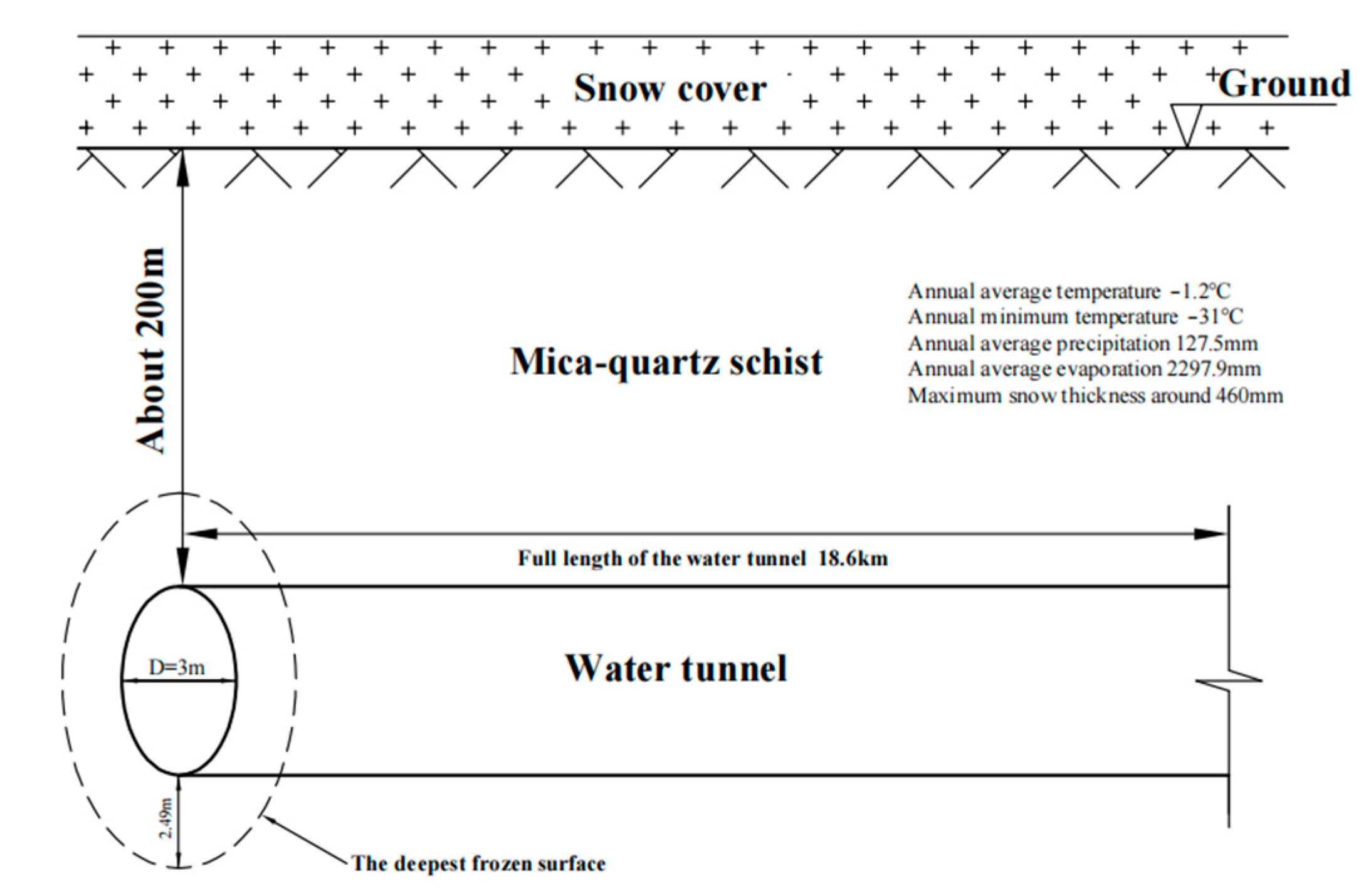
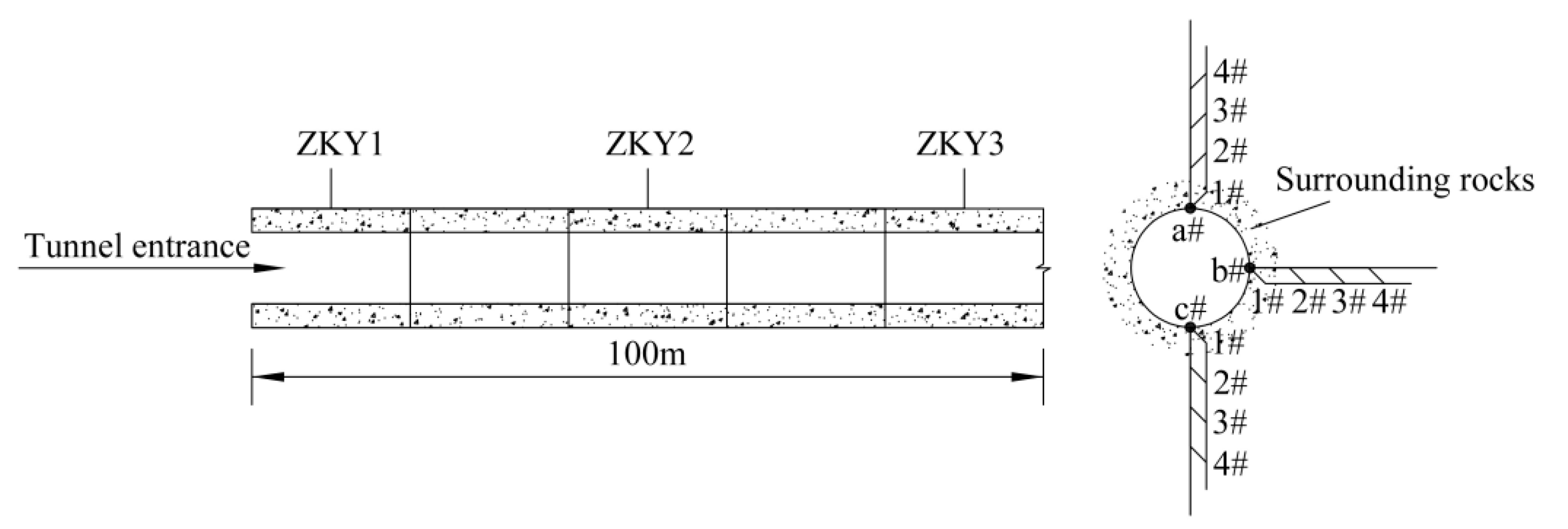

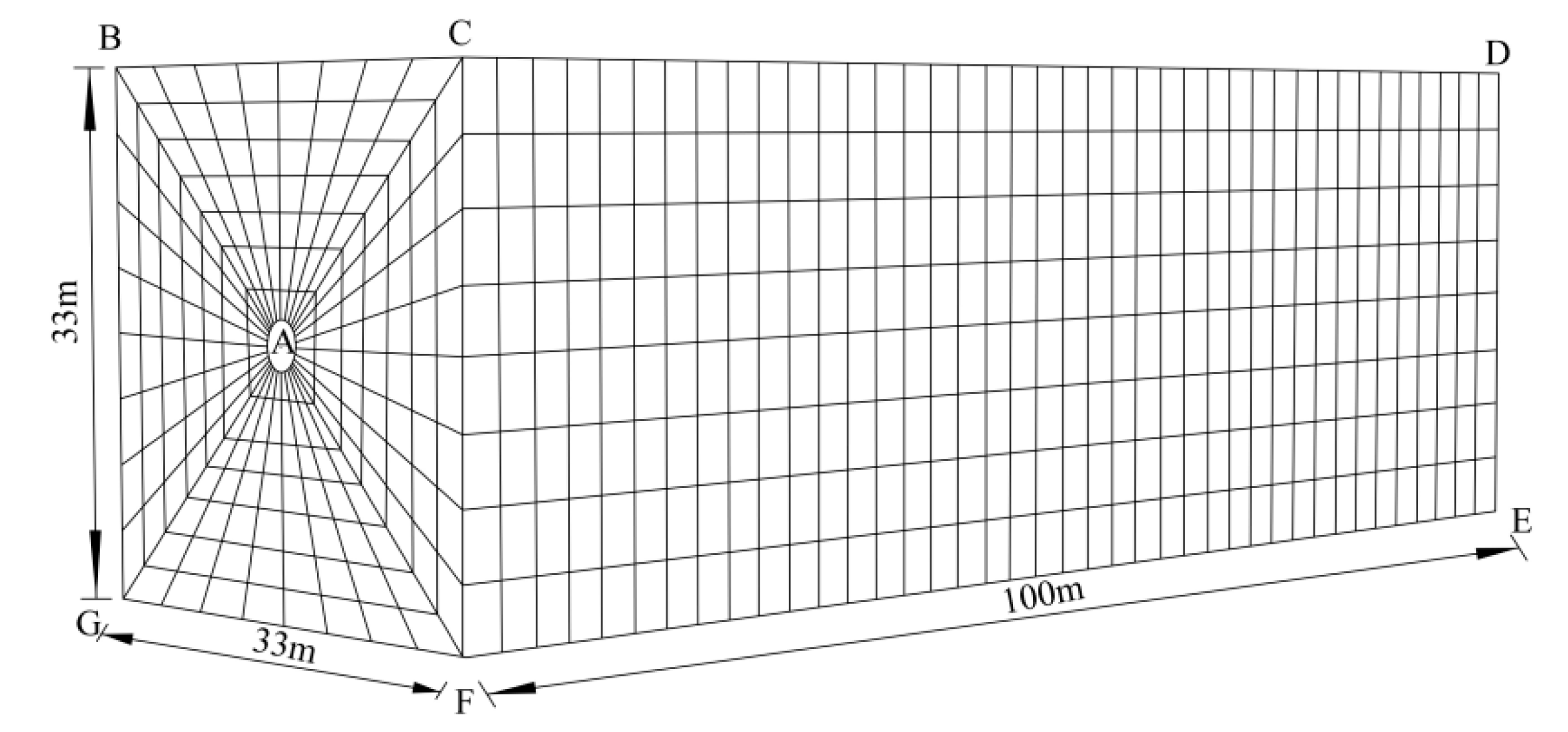


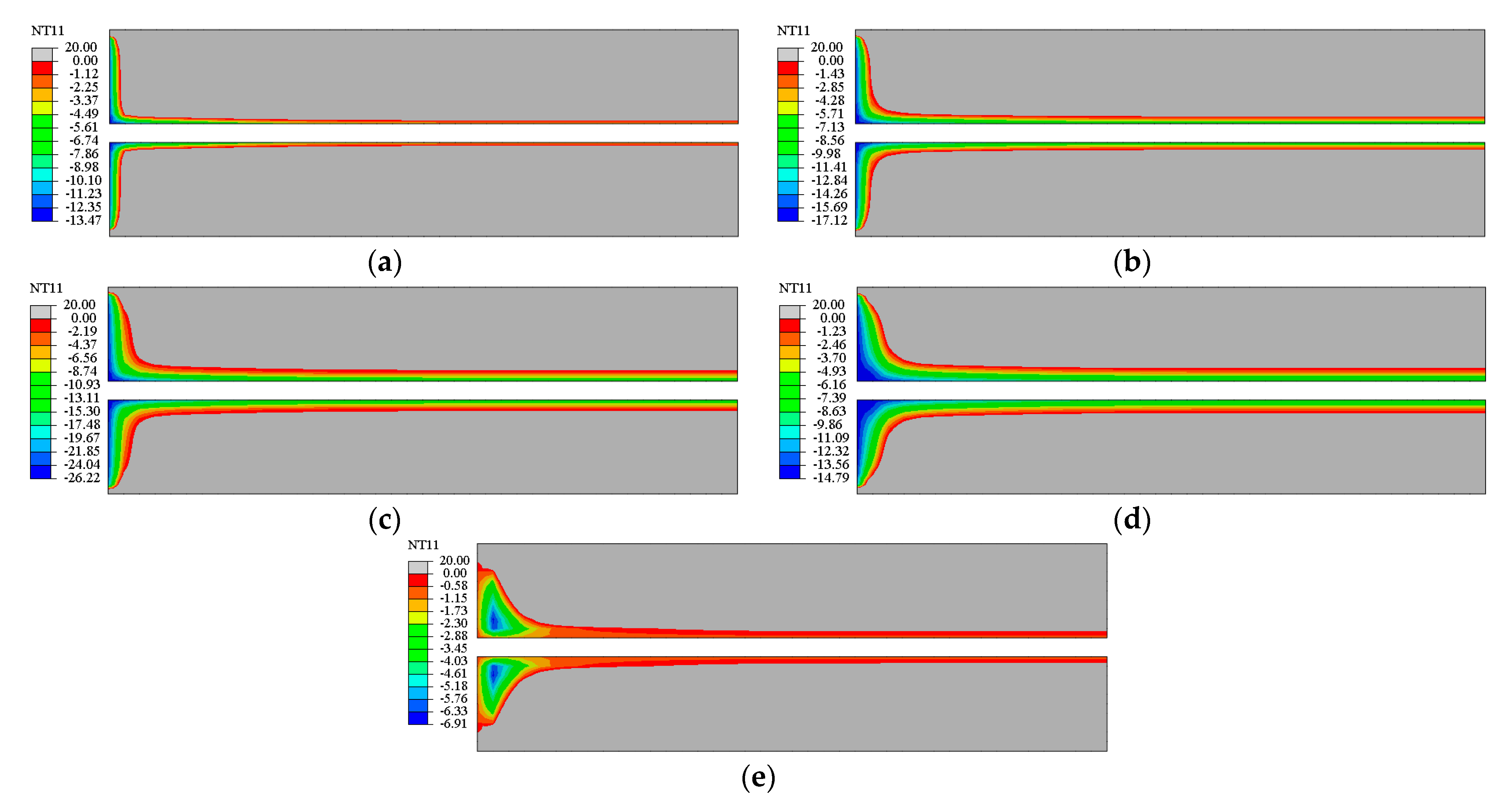



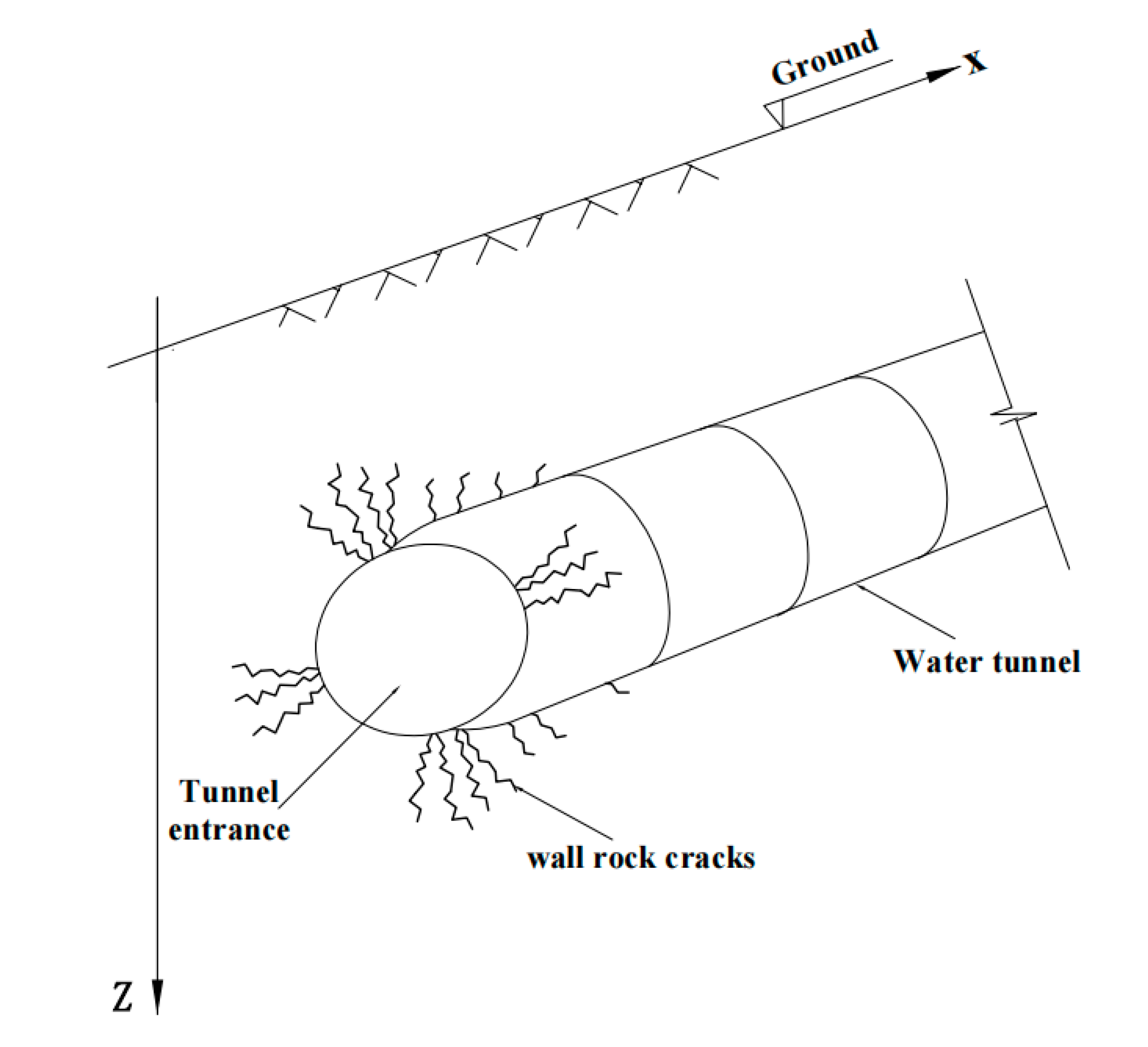
| Time Node | ZKY1 | ZKY2 | ZKY3 | ||||||
|---|---|---|---|---|---|---|---|---|---|
| ZKY1-a# | ZKY1-b# | ZKY1-c# | ZKY2-a# | ZKY2-b# | ZKY2-c# | ZKY3-a# | ZKY3-b# | ZKY3-c# | |
| 60 d | −0.22 | 0.17 | −0.20 | −0.17 | 0.11 | −0.16 | −0.17 | 0.10 | −0.16 |
| 95 d | −0.36 | 0.26 | −0.35 | −0.25 | 0.21 | −0.23 | −0.24 | 0.19 | −0.22 |
| 130 d | −0.56 | 0.33 | −0.54 | −0.43 | 0.29 | −0.42 | −0.41 | 0.28 | −0.41 |
| 165 d | −0.63 | 0.41 | −0.61 | −0.51 | 0.35 | −0.49 | −0.51 | 0.35 | −0.48 |
| 200 d | −0.31 | 0.20 | −0.31 | −0.21 | 0.14 | −0.21 | −0.21 | 0.12 | −0.20 |
| Materials | Density ρ/(kg/m3) | Elastic Modulus E/GPa | Poisson Ratio μ | Cohesion c/MPa | Internal Friction Angle φ/(°) | Thermal Conductivity λ/(w/(m·°C)) | Specific Heat Capacity C/(J/(kg·°C) | Porosity n | Permeability Coefficient k/(m/s) |
|---|---|---|---|---|---|---|---|---|---|
| Frozen surrounding rocks | 2130 | 4.1 | 0.27 | 0.41 | 37 | 3.17 | 1260 | 0.27 | 6.8 × 10−6 |
| Unfrozen surrounding rocks | 2130 | 3.2 | 0.30 | 0.47 | 30 | 2.25 | 1534 | 0.27 | 2.4 × 10−5 |
Publisher’s Note: MDPI stays neutral with regard to jurisdictional claims in published maps and institutional affiliations. |
© 2022 by the authors. Licensee MDPI, Basel, Switzerland. This article is an open access article distributed under the terms and conditions of the Creative Commons Attribution (CC BY) license (https://creativecommons.org/licenses/by/4.0/).
Share and Cite
Jiang, H.; Zhai, D.; Xiang, P.; Wei, G. Research on Frost Heaving Characteristics of Hydraulic Tunnels’ Wall Rock in Cold Regions Based on Phase Transition and Water-Heat-Stress Coupling. Buildings 2022, 12, 1026. https://doi.org/10.3390/buildings12071026
Jiang H, Zhai D, Xiang P, Wei G. Research on Frost Heaving Characteristics of Hydraulic Tunnels’ Wall Rock in Cold Regions Based on Phase Transition and Water-Heat-Stress Coupling. Buildings. 2022; 12(7):1026. https://doi.org/10.3390/buildings12071026
Chicago/Turabian StyleJiang, Haibo, Dongsen Zhai, Pengfei Xiang, and Gang Wei. 2022. "Research on Frost Heaving Characteristics of Hydraulic Tunnels’ Wall Rock in Cold Regions Based on Phase Transition and Water-Heat-Stress Coupling" Buildings 12, no. 7: 1026. https://doi.org/10.3390/buildings12071026






